what telescope do i need to see saturns rings
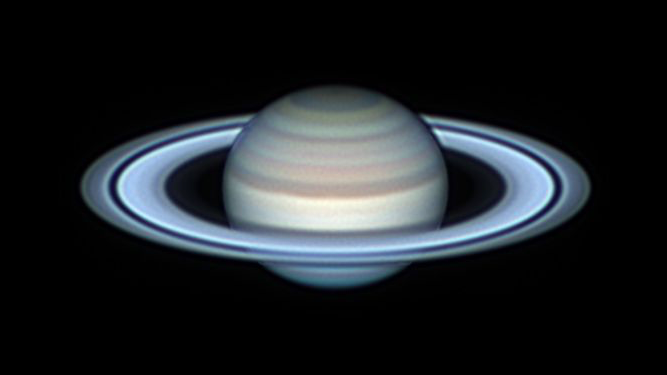
Saturn's rings are cute
Saturn is the most gasp-inducing planet when viewed through a telescope. And it's currently providing its all-time views of 2021 as it reaches its August 1-2 opposition. Saturn looks starlike to the center alone. It appears as as a golden-hued dot and shines steadily, as planets tend to exercise. Binoculars will raise its color, and fifty-fifty a minor telescope will let you glimpse Saturn's rings. Veteran observer Alan MacRobert at SkyandTelescope.com has written:
The rings of Saturn should be visible in fifty-fifty the smallest telescope at 25x [magnified by 25 times]. A proficient 3-inch scope at 50x [magnified by 50 times] can evidence them as a separate structure detached on all sides from the ball of the planet.
Desire to see Saturn's rings? Outset, you need to find Saturn in the sky. It's not hard! Information technology's currently in the southeastern sky not far from the horizon after sunset. Ii bright starlike dots appear in this region of sky. The brightest is Jupiter, and to its upper correct is Saturn.
Jupiter outshines all the stars, and then its proximity to the ringed planet volition make finding Saturn a breeze. Saturn volition be out all night long in early on August 2021, whereas Jupiter will be out all night long by belatedly August 2021. Thereafter, these 2 giant worlds volition remain fixtures of the evening sky for the rest of the yr. You can find the moon below Saturn on August 20 and beneath Jupiter the next dark.

Attending a star party or astronomy club
Okay, got Saturn? Now … about that telescope. One possibility is to starting time scouting out a star party about you, where apprentice astronomers are set up to show you lot telescopic objects. Check the club map at NASA's Night Sky Network to discover star parties. Or endeavour this list of astronomy clubs past land from the Astronomical League. Or call a local academy or science museum and ask virtually star parties. Or maybe a neighbour, or friend, has a telescope stashed in a cupboard? More possibilities:
Astronomy Clubs Nigh Me & Organizations, from SkyandTelescope.com.
2018 Astronomy Lodge Directory, from Go-Astronomy.com.
Astronomy Clubs Most Me, from LoveTheNightSky.com.
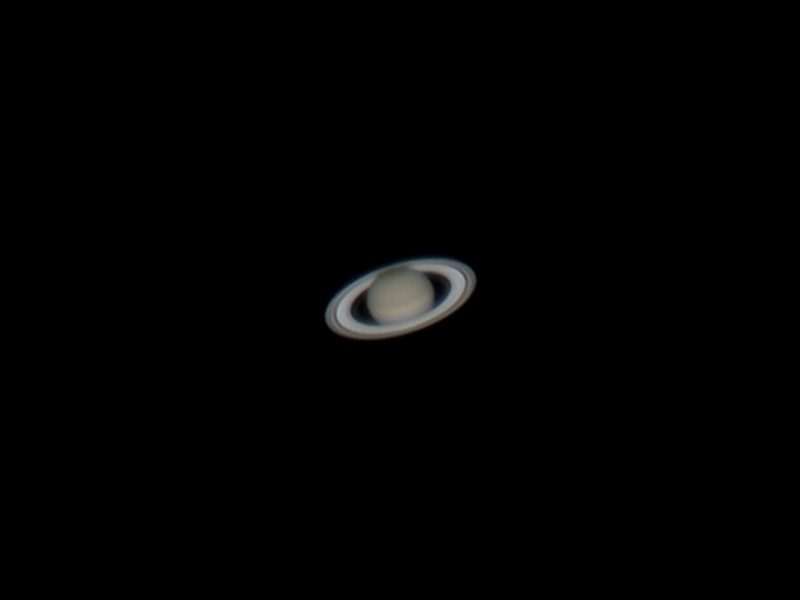
Observing tips for Saturn'south rings
In one case you can find Saturn in the heaven and accept a star party to nourish, think virtually these items before your ring-viewing session:
1. Telescope. Don't await to run into the rings in binoculars. You really do need a telescope. A bigger telescope will bear witness you more than than a smaller telescope. Check out the dissimilarity betwixt the two photos below.
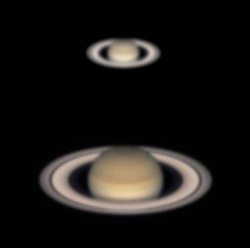
2. Tilt. Discover the tilt of the rings. As with so much in space (and on Earth), the appearance of Saturn's rings from Earth is cyclical. In 2017, the north side of the rings opened up most widely (27 degrees), as seen from World. That's the most open this face up of the rings has been since since 1988. In 2021, the bending is downwardly to eighteen degrees but still very easy to see the expanse of the rings equally we look at the planet's northern hemisphere. By the year 2025, the rings will announced edge-on as seen from Globe. At such times, considering the rings are and so thin, it's possible to view Saturn through a telescope as if it has no rings at all! After that, nosotros'll begin to come across the south side of Saturn's rings and their openness volition gradually increase to a maximum inclination of 27 degrees by May 2032.
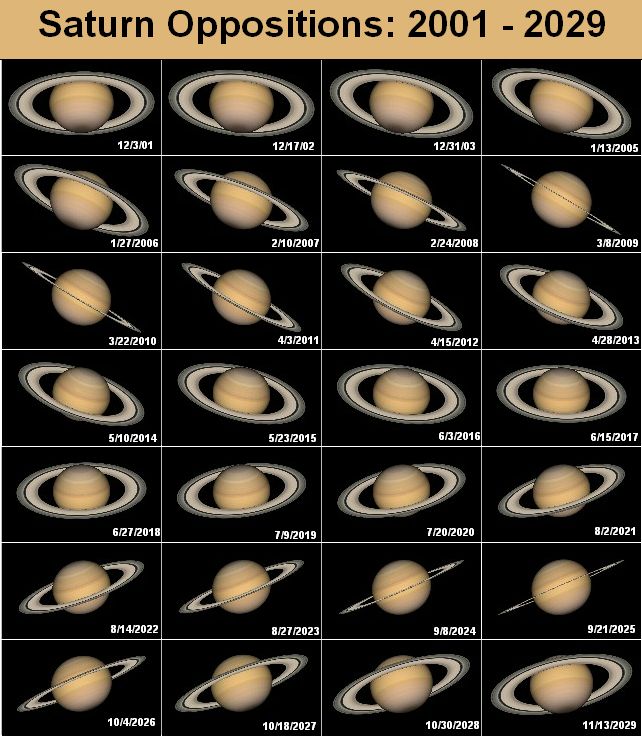
3. 3D. Ask yourself … do Saturn's rings look three-dimensional? Again quoting Alan MacRobert at SkyandTelescope.com:
Saturn has a more three-dimensional appearance than any other object in the sky; at least that's how it looks to me with a 6-inch 'scope on a night of fine seeing.
You may exist able to distinguish a shadow on the planet made past the ring in front, and a shadow on the farther ring cast by the planet, which will help the epitome of Saturn popular.
4. Seeing. What was Alan talking nigh in that quote above when he mentioned seeing? Both amateur and professional astronomers talk about the nighttime'due south seeing, which affects how conspicuously and sharply you can see a telescopic image. Seeing isn't a quality of the telescope; it's a quality of the air above yous. It's the reason the stars twinkle more on some nights than others. When the air is particularly turbulent, astronomers say there's bad seeing. The images at the telescope shimmy and dance. When the air is specially still, astronomers say there'southward proficient seeing. Seeing can shift from moment to moment, equally parcels of air move above you. So, as y'all're gazing at Saturn, stand as quietly equally you lot tin – for equally long every bit you can – and just look. You lot'll notice moments when the image suddenly comes into sharper focus.

v. Other things to think nigh. In one case you get comfortable viewing Saturn – bold you're able to view it again and again, with a telescope of your own – you'll begin to notice details in the rings. Today, thank you to spacecraft, we know that Saturn's rings are incredibly detailed. But, as you stand at your telescope gazing upward, you might exist thrilled to witness just one primary division in the rings, the Cassini Division between the A and B rings, named for its French discoverer Jean Cassini. Seeing this nighttime division is a good test of the nighttime's seeing and your telescope's optical quality, and also of your ain optics' power to just look and notice what you encounter. Past the mode, if you're looking at the rings – which means y'all're viewing Saturn through a telescope – look also for 1 or more of Saturn'due south many moons, well-nigh notably Titan.
Take fun!
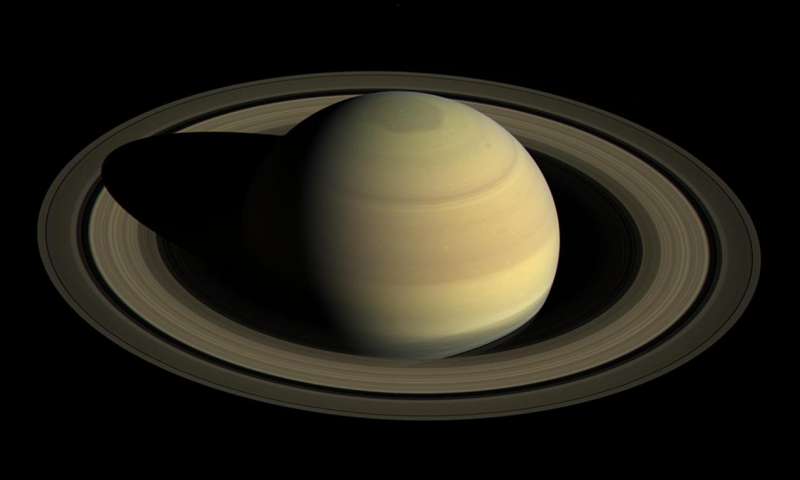
Bottom line: If y'all want to see Saturn's rings, August 2021 is a not bad fourth dimension to look. Catch a telescope and read the tips found hither!
Read more than … Viewing Saturn: Rings, Planet and Moons
Aid EarthSky keep going! Please donate.
Source: https://earthsky.org/astronomy-essentials/viewing-saturns-rings-tips-for-beginners/
Post a Comment for "what telescope do i need to see saturns rings"